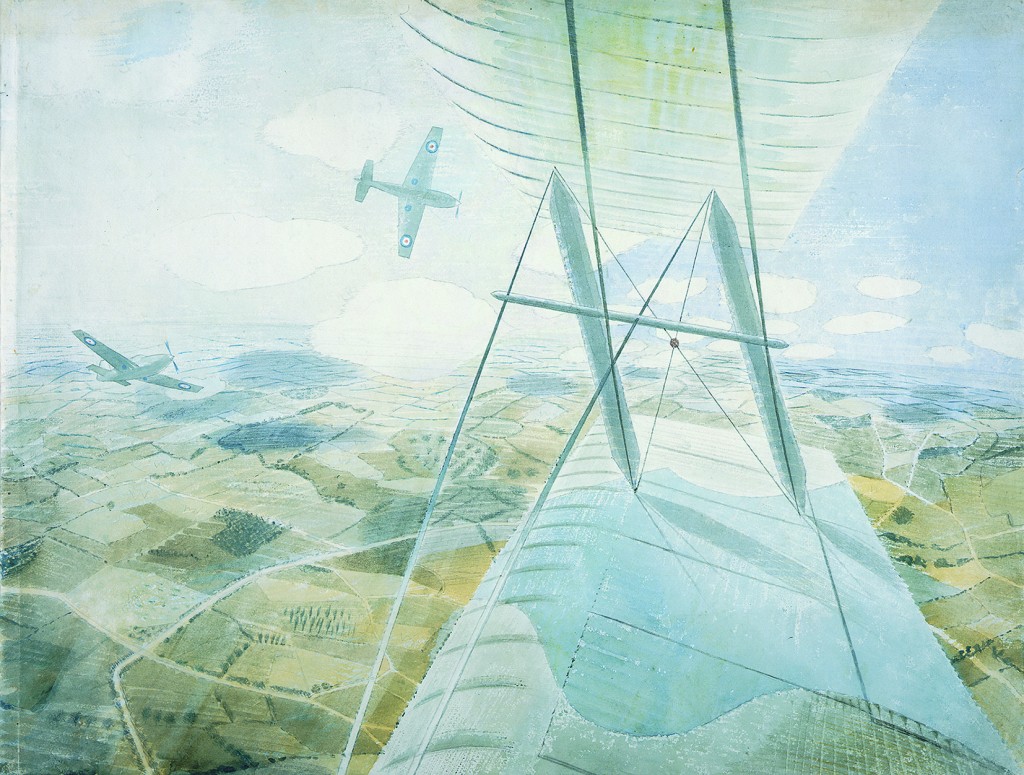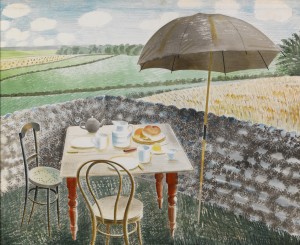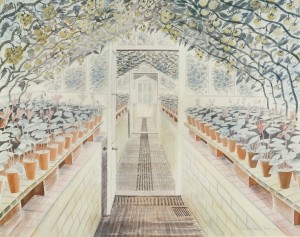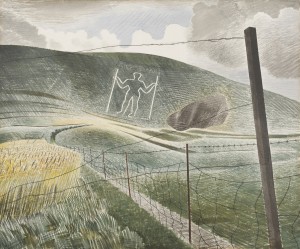
An exhibition titled ‘Ravilious’ has just opened at the Dulwich Picture Gallery. It focuses on the watercolours of the celebrated artist and designer, Eric Ravilious. Ravilious has been described as one of the finest watercolourists of the 20th Century and his life and work has strong connections to Sussex.
During Eric Ravilious’ lifetime watercolour painting underwent a revival. This most English of mediums and traditions was fused with modern ways of seeing and painting. The graphic, linear approach to the medium resulted in a very English Modernism.
Born in 1903, Eric Ravilious’ childhood was spent in Eastbourne where his father ran an antiques shop. In 1934 Eric Ravilious, once again, returned to Sussex staying at Furlongs with Peggy Angus who had rented a shepherd’s cottage in sight of Firle. Here he painted landscapes and local scenes. The exhibition highlights that his work is rooted in the landscape and life of pre-war and wartime England. Sussex and the South Downs are strong influences.

Interior and domestic scenes are a recurring theme in his watercolours. Take for example ‘Tea at Furlongs’ painted in 1939. This domestic scene captures a moment in time at odds with the war which would imminently engulf our nation. The table is laid with an appealing English afternoon tea, placed in a natural landscape. The garden at Furlongs is truthfully depicted by the artist. Light and movement appear to dance across the surface of the paper. The gentle distortion of perspective heightens the viewer’s connection with the scene, its composition drawing us in. Ravilious’ ability to be economical in choosing detail and his use of shapes and distorted perspective is always informed by the needs of the compositions in his watercolours.

The discovery of a greenhouse at nearby Firle Place in 1935 was the inspiration for ‘Cyclamen and Tomatoes’. The exemplary composition beguiles the viewer. Orderly rows of terracotta flowerpots are framed by the arched canopy of tomato vines. A series of similar watercolours followed. There is a stillness which is out of time, a quality often found in his paintings.
Edward Bawden, his lifelong friend and fellow artist, would recall how Ravilious worked straight onto the final piece without preparatory sketches. He would lightly sketch in the main forms in pencil and then areas of paint in turn rather than working across the entire sheet of paper. A white resist was used to preserve white throughout the whole process. This practice gifts his work with an immediacy and liveliness of invention.

In 1944 the poet and dramatist Lawrence Binyon wrote describing how Ravilious employed under-painting, elaborate superimposed washes and stipples resulting in great delicacy and definition. His style built on the tradition of late 18th and early 19th century English watercolour painting. As he re-examined work by artists like John Sell Cotman he found a very English corrective to modernism resulting in his emotionally cool and intensely structural paintings.
In December, shortly after the outbreak of war on the 3rd September 1939 Ravilious toured and recorded England’s chalk figure sites. The Long Man of Wilmington was familiar to Ravilious from his childhood. Ravilious likened the ‘Wilmington Giant’, near Eastbourne, with a figure of Virgo holding staves in the frescoes of San Gimignano by Bartolo di Fredi of ‘Scenes from Creation’. The lines of the barbed wire and distorted mesh fence draws the eye to the tilted figure. The patch of corn answers the flash of blue in the sky, the hatching in the fields and hill echoed in the scudding clouds. This is a landscape which speaks of the English and the ancient.
At the outbreak of war Ravilious had joined the Observer Corps at Castle Hedingham, becoming a war artist in 1940.
He would often fly with the RAF. The remarkable study ‘Hurricane in Flight’ depicts two Hurricanes banking. The artist’s technique is once again illustrated. The bi-plane wing concentrates our eye on the fighter planes in an extraordinary composition. The scene is framed against the patchwork quilt of fields in the timeless English countryside. Here the common threads which unite Ravilious’ paintings in peace and wartime are displayed. Threads which are central to the Dulwich Picture Gallery’s exhibition.
Ravilious was lost when the air sea reconnaissance mission he had joined in a Hudson aircraft failed to return from its search. He died with the airmen he so admired.
Ravilious’ sensibility was modern but his techniques were not. Texture, light and movement connect the artist’s work to the English Romantic tradition but with a particular and fresh voice. It is at once figurative and yet highly stylized. Watercolour, a most English of mediums, is fused with modern ways of seeing and painting. His graphic, linear approach to the medium resulted in a very English Modernism in peace and wartime. This superb chronological exhibition allows us to see Eric Ravilious’ development as an artist and the techniques, themes and subjects which unite his peace and wartime work.
‘Ravilious’ runs at the Dulwich Picture Gallery until the 31st August 2015 and is one of this year’s must see exhibitions. For more information go to www.dulwichpicturegallery.org.uk.
By Revd. Rupert Toovey. Originally published on 22nd April 2015 in the West Sussex Gazette.